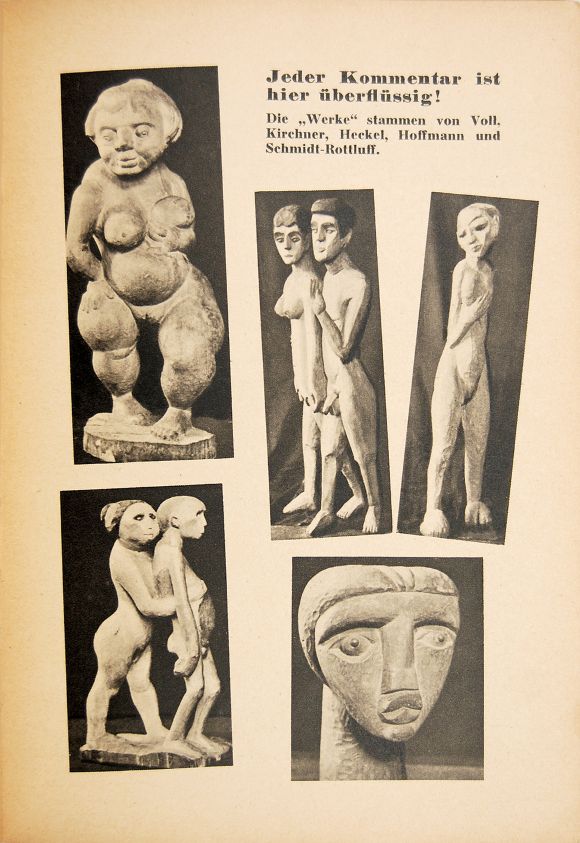Archive Treasures - Degenerate Art
On July 19, 1937, the “Degenerate Art” exhibition (Entartete Kunst) opened at the Munich Archaeological Institute. It aimed to expose the German public to the moral decay of the Weimar Republic as reflected in what it called “the old art”—that is, the modernist avant-garde that preceded the National Socialist revolution.[1] Hastily organized in just three weeks, the exhibition was conceived as a counter-exhibition to the “Great German Art Exhibition” (Große Deutsche Kunstausstellung), which had opened the day before, a short walking distance away: a state-sponsored showcase of conservative, realist, and nationalistic art aligned with Nazi ideals.[2] More than two million people visited the “Degenerate Art” exhibition during the five months it remained in Munich before it travelled to other cities across the Reich.[3]
.jpg)
Postcard showing the Berlin Kunsthalle, where the “Degenerate Art” exhibition was hosted in 1938. Uncredited photographer, CC BY-SA 4.0, via Wikimedia Commons.
The exhibition featured approximately 650 artworks confiscated from museums and cultural institutions across Germany, the majority by non-Jewish artists.[4] The works were hung in crowded, chaotic arrangements, mixing different movements and styles, accompanied by incorrect labels and decontextualized quotations.[5] Slogans like “Your jaw drops!” and “Come and judge for yourselves!” were plastered on the walls, designed to provoke outrage and agitate the crowd.[6] As the exhibition closed, most of the works were not destroyed but instead hidden away or sold at auction.[7]
The exhibition catalogue, published in late November 1937 as the Munich showing concluded, serves as a sharp ideological manifesto—a sweeping indictment of what it calls the “Judeo-Bolshevist” cultural elite, accused of confusing and alienating the general public and mocking its values.[8] The reproductions included in the catalogue are secondary to the ideological text, which is laced with quotations from Hitler’s speeches on German art and culture. The catalogue does not concern itself with the formal qualities or the historical context of the artworks. Rather, it focuses on the political, racial, and moral motivations behind the modernist avant-garde, framing it as an organized assault on German culture—a deliberate process of disintegration intended to “damage the essence of art and its continued existence.”[9] The catalogue does not reject any particular artistic style so much as present modern art as part of a broader conspiracy to spread of political anarchy, cultural Bolshevism, and Jewish domination of public institutions and cultural funding. Blame is not placed on the artists—who are depicted, at most, as weak-willed collaborators—but rather on the curators, collectors, and institutions that granted their work the status of legitimate art.[10]
The Wiener Library holds a rare first edition of the exhibition catalogue, printed in 1937. The catalogue has been digitized and is available through the Wiener Online Archive, linked here.

Page from the exhibition catalogue, featuring sculptures by Voll, Kirchner, Heckel, Hoffmann, and Schmidt-Rottluff. The printed caption at the top reads: “Any comment here is superfluous!”
From: Kaiser, Fritz. Entartete Kunst: Führer durch die Ausstellung. Berlin: Verlag für Kultur- und Wirtschaftswerbung, 1937.
[1] Neil Levi, “Jews, Art, and History: The Nazi Exhibition of ‘Degenerate Art’ as Historicopolitical Spectacle,” in Modernist Form and the Myth of Jewification (New York: Fordham University Press, 2014), pp. 52, 54-55.
[2] Ibid, p. 52.
[3] Ibid.
[4] Ibid, p. 57.
[5] Ibid, p. 54.
[6] Ibid, p. 65.
[7] Ibid, p. 57.
[8] Ibid, p. 67.
[9] Entartete Kunst: Ausstellung im Archäologischen Institut der Universität München (Berlin: Verlag für Kultur- und Wirtschaftswerbung, 1937), unpaginated. English translation by the author.
[10] Levi, pp. 54, 73.


